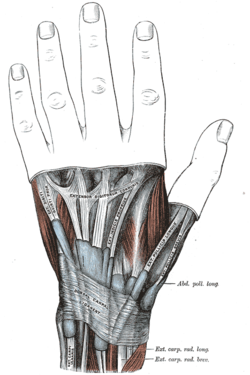|
Anatomical snuffbox
The anatomical snuff box or snuffbox or foveola radialis is a triangular deepening on the radial, dorsal aspect of the hand—at the level of the carpal bones, specifically, the scaphoid and trapezium bones forming the floor. The name originates from the use of this surface for placing and then sniffing powdered tobacco, or "snuff."[citation needed] It is sometimes referred to by its French name tabatière. StructureBoundaries
Neurovascular anatomyDeep to the tendons which form the borders of the anatomical snuff box lies the radial artery, which passes through the anatomical snuffbox on its course from the normal radial pulse detecting area, to the proximal space in between the first and second metacarpals to contribute to the superficial and deep palmar arches. In the anatomical snuffbox, the radial artery is closely related (<2 mm) with the superficial branch of radial nerve near the styloid process of radius in 48%, while in 24% the radial artery is openly related to the lateral cutaneous nerve of forearm.[2] The cephalic vein arises within the anatomical snuffbox, while the dorsal cutaneous branch of the radial nerve can be palpated by stroking along the extensor pollicis longus with the dorsal aspect of a fingernail. Clinical significanceThe radius and scaphoid articulate deep to the snuffbox to form the basis of the wrist joint. In the event of a fall onto an outstretched hand (FOOSH), this is the area through which the brunt of the force will focus. This results in these two bones being the most often fractured of the wrist. In a case where there is localized tenderness within the snuffbox, knowledge of wrist anatomy leads to the speedy conclusion that the fracture is likely to be of the scaphoid. This is understandable as the scaphoid is a small, oddly shaped bone whose purpose is to facilitate mobility rather than confer stability to the wrist joint [citation needed]. In the event of inordinate application of force over the wrist, this small scaphoid is likely to be the weak link [citation needed]. Scaphoid fracture is one of the most frequent causes of medico-legal issues. An anatomical anomaly in the vascular supply to the scaphoid is the area to which the blood supply is first delivered. Blood enters the scaphoid distally. Consequently, in the event of a fracture the proximal segment of the scaphoid will be devoid of a vascular supply, and will—if action is not taken—avascularly necrose within a sufferer's snuffbox. Due to the small size of the scaphoid and its shape, it is difficult to determine, early on, whether or not the scaphoid is indeed fractured with an x-ray. Further complications include; carpal instability (ligament disruption) and fracture-dislocations. Additional images
See alsoReferences
External linksWikimedia Commons has media related to Anatomical snuff box. |
||||||||||||||||||||||||






